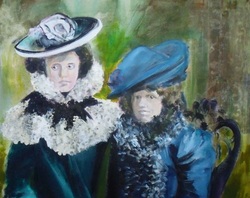|
As a relative newcomer to Facebook, I am still exploring its many and varied facets. One that I have known about for a while is that you can play SCRABBLE on line via this interface. A while back my friend Dale had invited me to play with her, but my limited understanding of how to get this going took me a while to engage.
Until this week. I have been inside all week with a virus, and therefore finding perfect couch and Kleenex time to play. I now have games going with Dale (who, incidentally turns out to be a barracuda that beats me most of the time), my daughter, several anonymously numbered people, and a cat named Janet. Janet is also beating me, and I think it's because a lot of the words are in cat language. Words such as "ur" and "ch" are denoted as acceptable, but not ipad, which is clearly a word since I am playing SCRABBLE on it. Maybe I will have to get a cat. a-a-a-achoo!
0 Comments
 I started this a while back and am reminded to finish it by the recent opening of the Clarington Museums exhibition Rediscovering Identity: The Power of Photography. This is a multi dimensional exhibit that allows visitors to explore many facets of the medium, its mechanics as well as its history. Local artists were asked to interpret a photograph from the archives, so several IRIS members jumped at the chance to do some portraiture and I chose a photograph of what I assume to be two sisters, dressed to the nines and looking a little nonplussed. Special guest speaker at the opening was Steven Frank, who spoke about the history of photography, and showed some 19C - early 20C artifacts such as a stereoscope, wonderful leather bound album, and postcard book. Photographer Jean Michel Komarnicki recently commented that it isn't a photograph until it's printed, and that got me thinking about our existences within Walter Benjamin's famous age of mechanical reproduction. We are rapidly moving out of this era as the evanescent digital age overtakes us, and as the majority of images that we capture never become hard copy. As JMK pointed out, technological changes as well as material degradation of discs may make digital records unreadable in time. And how about those rapidly fading colour prints from the 1960s? Artists are still, of course creating photographs, mostly printed digitally, but with archival considerations. But the family photos that record so much of daily life, special events, travels etc. are mostly shown on screens rather that stored in albums. It is noteworthy, as Frank mentioned, that when disaster destroys peoples' homes the victims invariably mention the loss of those family albums. They tell the stories of our lives and become the stories that are remembered. But they are going. The earliest extant photograph is believed to be "View from the Window at Le Gras" by Nicéphore Niépce in 1826 or 1827. So figuring that by 2025 or so there won't be any more family albums, we can look at this two hundred year period as the age of the photograph. While the latter 20th century will have the richest repository of printed memories, it is possible to look at pictures taken before 1900 and gain a sense of how people dressed, celebrated, wanted themselves to be recorded. Those long exposure times invite an equally long examination of the images. Will future generations have this privilege? |
Archives
February 2024
|
Margaret Rodgers | Canada

 RSS Feed
RSS Feed